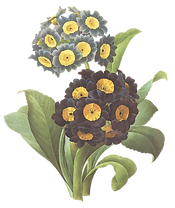
European Mistletoe or Viscum Album is a parasitic plant, growing on the branches of trees, where it forms pendent bushes, 2 to 5 feet in diameter. The stem and leaves are a greenish-yellow color. The leaves, tongue-shaped and 1 to 3 inches long, are very thick and leathery and grow in pairs. The flowers are small and grow in threes. They open in May and become one-seeded, round, smooth, white berries that ripen in December. They are then eaten by birds, thereby spreading the mistletoe to other trees.
Mistletoe is found throughout Europe and the berries, leaves, and stems of European mistletoe have been used medicinally for centuries. Celtic priests, known as druids considered the plant to be sacred. For this reason the Celts placed a sprig of mistletoe above the door of their houses and they believed that its sacred nature prohibited fighting beneath it. This evolved over centuries into the custom of kissing underneath mistletoe at Christmas.
Although Mistletoe is considered a Monday herb because of its’ strong anti-spasmodic/epileptic properties, our Mistletoe tincture is focused on cancer treatment so it was made as a Mars (Tuesday) herb to improve our immune system along with fighting cancer.
Health Benefits of Mistletoe
Cancer: Mistletoe (European) is the most widely studied alternative therapy for cancer (NCI). It has been touted as a strong preventative against cancer and is widely used in Europe-especially Germany. It stimulates the immune system and extracts have been known to kill cancer cells in vitro. It is said to reduce tumor size, improve blood counts, help improve the quality of life and improve the survival of some cancer patients, especially those using chemo and radiation. It may also help reduce pain and side effects from these treatments i.e. nausea/diarrhea, numbness and tingling, hair loss, fatigue and emotional well-being. **Suzanne Somers even used it to treat her breast cancer.
Epilepsy/Convulsions/Convulsive Issues: Mistletoe had been known primarily as an antispasmodic, helping with epileptic seizures, convulsions and even convulsive coughing issues as well as bronchial asthma, and asthmatic attacks. Its calming properties help relieve the psychological tension that occurs when an asthmatic has difficulty in drawing breath. Its’ antispasmodic properties can even help with menstrual cramps.
Inflammation: Mistletoe is believed to be a natural anti-inflammatory and has been used to treat inflammation including arthritis and other joint pains. Germany has approved it as a treatment for degenerative and inflamed joints.
Diabetes: Mistletoe has a long history of use for diabetes. Research has shown that it can reduce blood sugar levels and regulate the body’s insulin levels.
Heart/Blood Pressure: There is evidence that mistletoe can impact hypertension and high blood pressure. Japanese researchers found both Japanese and European mistletoe extracts had blood pressure lowering effects.
It also has the potential to prevent atherosclerosis or the build-up of plaque in the arteries which can cause many dangerous heart conditions


